
by Naomi Lubick Wednesday, March 16, 2016
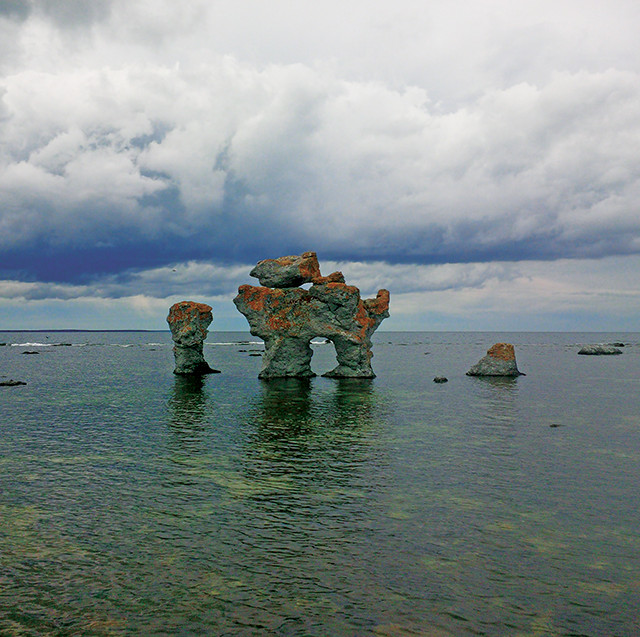
The iconic sea stacks, called raukarna, of Langhammars Nature Reserve on Fårö Island are the remnants of Silurian coral reefs. Credit: Naomi Lubick.
White sand beaches and thatched-roof houses probably are not part of most people’s conception of Sweden, yet they are characteristic of this northern European nation’s very own coral reef island getaway. This is no tropical island, mind you: 3,100-plus-square-kilometer Gotland sits squarely in the Baltic Sea, off the southeastern shore of Sweden just a short trip from the capital, Stockholm. My husband and I had heard about Gotland since we moved to Sweden several years ago. Swedes extol their country’s largest island as a place with good food, great beaches and lovely summers.
They also admire the island’s geology. From sea stacks in the north to the west side’s chalk cliffs to the east coast’s white sand beaches, Gotland differs markedly from the granitic craton that forms most of the rest of Sweden and much of Norway. Among the rolling glaciated hills and metamorphosed granites and schists that make up the heart of the Scandinavian landmass, Gotland’s reef layers are an anomaly.
While my husband was skeptical about visiting the small island, for me, the clincher was photos of “the dog.” When viewed from a specific angle, the iconic sea stack looks like a statue of a gigantic terrier standing out in the water, surrounded by other oddly shaped sculptures. The sea stacks, called raukarna (RAW’-kahr-nuh), stand on the western shore of Gotland’s northern neighbor, Fårö (FOR’-uh), which means “Sheep Island.”
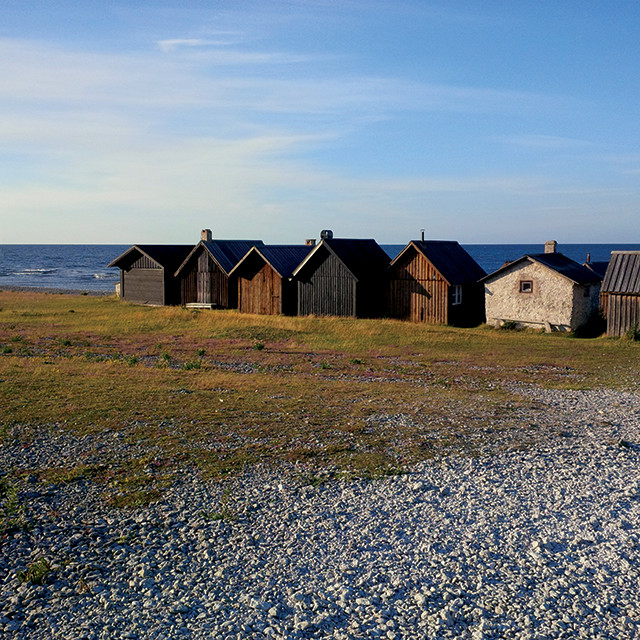
An 18th-century fishing village on the northwest coast of Fårö, which was used seasonally to catch, salt and dry herring. Credit: Naomi Lubick.
Swedes consider Gotland special, and Fårö — separated from Gotland only by a narrow channel — even more so. This small island of several hundred human inhabitants (and probably more sheep) was also the longtime home of Ingmar Bergman, the famed Swedish director who made many of his iconic movies, and lived out the last years of his life, here. Perhaps that bit of history should have tipped us off about the islands’ typical summer weather: The famously moody aura that Bergman achieved in his films was surely aided by the often cool and rainy conditions.
It indeed rained half the time we were on Gotland in mid-July. And I have to say that the dog was smaller than I thought it would be. Even so, an evening on the beach with the sea stacks, despite the cold winds blowing, was magical enough for me (a former geologist) to make the entire trip worthwhile. These rocks hold clues to the island’s deep past and served as our entry to its more recent history as well.
The raukarna are “erosional remnants,” says Mikael Calner, professor and head of the Department of Geology at Lund University. “They have been carved in very recent time — sculpted during the latest glacial period and sea-level lowering.” Sea level has gone up and down several times in the Baltic in the past 15,000 to 20,000 years, and the last glaciers retreated about 12,000 years ago. “The interesting thing is that the parts left as sea stacks are the cores of the reefs” that grew in the Silurian, Calner says, about 443 million to 416 million years ago.
“At the time, most of the continents were clustered south of Earth’s equator,” Calner says. “In the Silurian and following in the Devonian, you have the largest reef abundance on Earth ever.” The remains of the reefs captured in the raukarna contain a snapshot of an interesting ecological setting, he says: Shallow waters were home to sponges and corals that thrived in tropical latitudes, building huge sheets of carbonate similar to the Bahamas today. Stromatoporoids — which are sponges and quite distinct from the microbial mats that form similar-sounding stromatolites— were the main builders of Gotland’s reefs, along with tabulate and rugose corals.
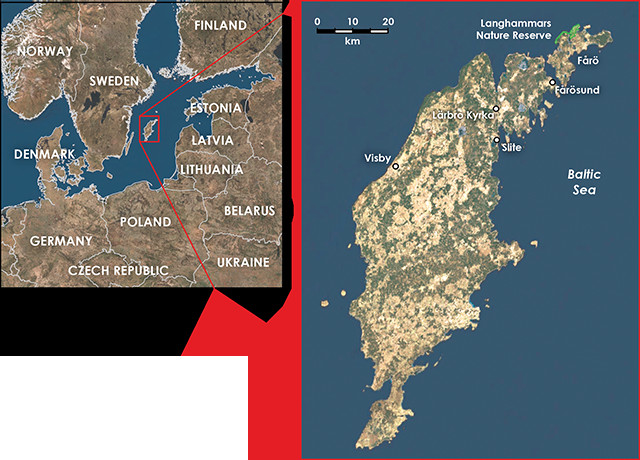
Gotland lies off the coast of Sweden in the Baltic Sea. Credit: both: K. Cantner, AGI.
Calner calls Gotland “a huge natural laboratory for doing research on this time slice. Before the Silurian was named the Silurian, it was named the Gotlandian. The rocks are the reason: the rocks are very pristine, well-preserved. They were never buried to deep depths, never overrun by orogenies. They are like a frozen Bahamas almost.”
Gotland’s fossil record has led geologists to reconsider the Silurian, which was once thought to be a calm period between the violent mass extinctions of the Ordovician and Devonian. The rocks instead reveal multiple small extinction events, in which conodonts and graptolites nearly disappeared from the record in pulses (and then recovered in some cases).
Researchers hashed out the details at an international conference in Gotland in 2005, where it became clear that all those small extinction events added up to a turbulent time in the Silurian. Massive climate fluctuations, governed largely by changes in carbon dioxide concentrations, led to shifts in ocean circulation and sea level, which in turn changed the biodiversity of these shallow tropical reefs — and thus the composition of their remnants today.
That geologic past continues to shape the life of the island: where there’s limestone, scraggly pines grow and twist in the wind. Where there’s mudstone marl, agricultural activity flourishes, Calner says.
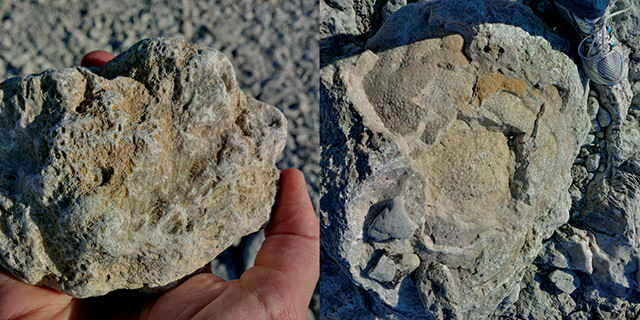
During the Silurian, Gotland's shallow waters were home to sponges and corals that thrived in tropical latitudes, building huge sheets of carbonate similar to the Bahamas today. Credit: both: Naomi Lubick.
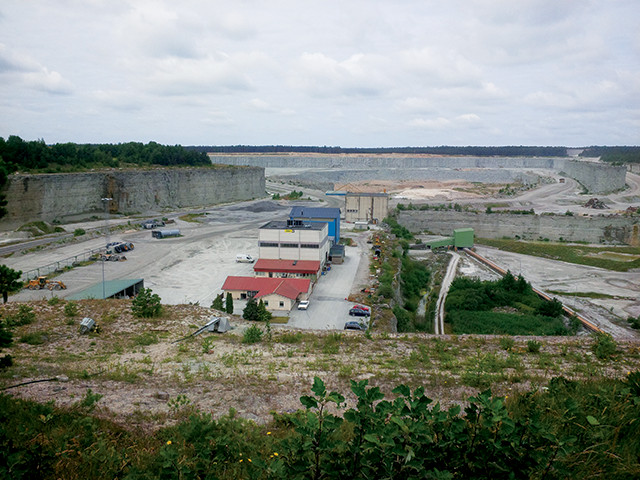
A limestone quarry near the town of Slite. Modern cement companies have worked on Gotland since the mid-1800s, but more primitive lime mortar has been produced here for far longer. Credit: Naomi Lubick.
And despite the less than balmy weather, humans have indeed flourished on Gotland. The shallow carbonate reefs are now topped by medieval churches and ancient burial sites, and Viking villages that have been modified over centuries into quaint old houses and farms. Its prime position in the Baltic made it a trading stop, from before the Middle Ages to the present. And its main city, Visby, is a U.N. World Heritage site where old church ruins are juxtaposed with modern restaurants, shops, and a local brewery. During our short trip, we managed to visit many of these features that set Gotland apart.
From Stockholm’s main station (Stockholm Centralen), we took a two-hour trip by train and then bus — both crowded with other travelers also headed to the island — to catch a weekday morning ferry to Gotland out of Nynäshamn. The ferry ride itself was a smooth 3.5-hour trip under gray skies.
When we arrived, the clouds had lifted, and we headed to the rental car hut outside the ferry terminal. We’d booked the equivalent of a Rent-A-Wreck, and despite the high price (Sweden is expensive in general, by American standards, and Gotland is even more so than the mainland), the rearview mirror fell off as soon as we started the car. A semi-apologetic employee came out with duct tape to help us reattach it and we were on our way.
Small two-lane highways crisscross Gotland, and we headed north on one that follows the west coast. The strata that make up the island are like a stack of books slightly tilted, as the tropical reef was laid down in shallow waters and the layers dip at about 1 degree (equivalent to a few meters over a kilometer). Short scrub-pine forests bordered the road, threaded by occasional stone fences. Patchy outcrops of smooth white carbonate gleamed where thin topsoil layers had worn away.
Winding along the coast, we pulled over to park beside a shake shack at a small harbor where tiny fishing boats were docked. There, we had our first taste of Gotland: sweet creamy ice cream flavored with saffron.
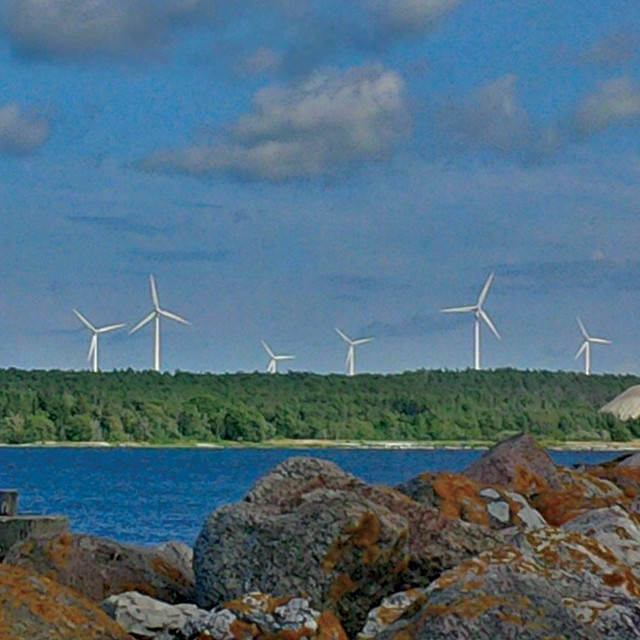
Gotland, in the Baltic Sea, once had 500 windmills. Modern w provide 15 percent of the island's electricity. Credit: Naomi Lubick.
The warm yellow color hinted at the island’s trading history: Saffron was one of many exotic ingredients — along with cinnamon, almonds and others — that made their way to Gotland even before the rise of the Hanseatic League, a merchant guild formed in the 1500s to protect trade among coastal cities in northern Europe. Those flavors are melded together in a traditional Gotland dessert called saffranspannkaka, which is more rice pudding than pancake. We had an excellent version at the YMCA café in Västerhejde, south of Visby, later in our trip. The shack also served lammkorv, or lamb sausages, another sign that we were on Gotland, home to many organically raised sheep.
After the delicious late-afternoon snack, we hopped back in the car to find our destination for the evening — a hostel we had booked near the north shore of the island. But there was no reason to rush: we had Swedish summer on our side, meaning the sun wouldn’t set until about 10 p.m. We stopped to gawk at Lärbro Kyrka, a medieval church (Gotland has nearly 100) with an octagonal, whitewashed central building and thick walls that bulge at the bottom. Two-meter-tall burial stones covered in carved runes lay propped against a wooden fence.
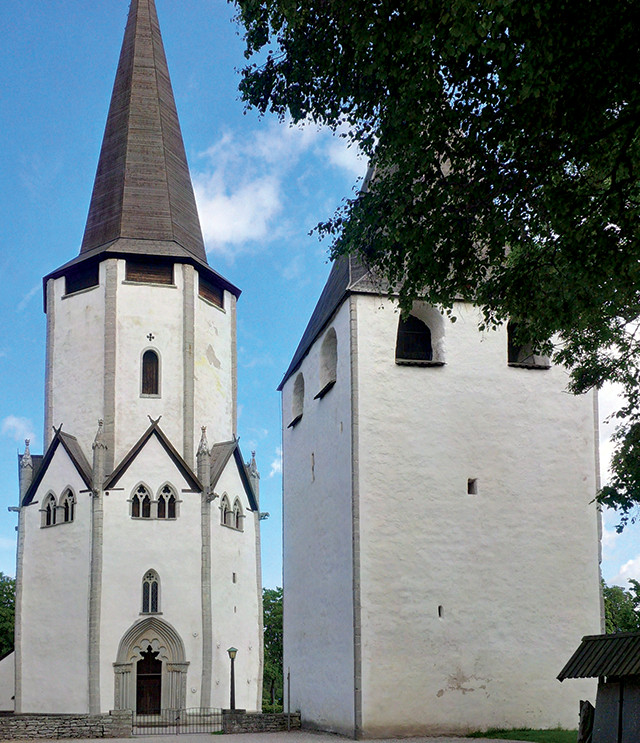
The abundance of medieval churches in Visby, including Lärbro Kyrka, speaks to the relative wealth and religious fervor of the 12th and 13th centuries. Credit: Naomi Lubick.
Toward the northern tip of Gotland, in a town called Fårösund (sund means “sound”), we pulled up next to the barracks of the STF Bunge hostel. Family style, with shared kitchens and bathrooms, and set beside an old airstrip, the hostel is part of the Swedish vandrarhem system, or “wanderers’ homes,” all over the country. We checked in, ditched our bags and headed for Fårö. After shopping at the local grocery store for a picnic supper, we waited our turn in the car queue for the 10-minute free ferry ride.
Once across the sound, we watched eagerly for the one-track road that would take us to the sea stacks in Langhammars Nature Reserve. The roads were not all clearly marked, but it is a small island, and eventually, after passing another medieval church, a café and a few roadside signs, we finally arrived at the rocks. As the sun descended toward the horizon, we wandered through the magical natural Stonehenge on the beach. I stopped again and again to peer down at the fossils beneath my feet: masses that reminded me of stromatolites popped up all over, interspersed with horned corals and what looked like brain corals. Some were stromatoporoids, the structured sponges that made up the bulk of the reefs. But a few of these cauliflower-shaped masses may have been oncoids, which are fossilized remains of microbial mats similar to stromatolites. A study of these oncoids by Calner’s student Martin Qvarnström suggested that they might have been a “disaster fauna” that thrived after a minor Late Silurian extinction event.
We wandered up the shore and back down, but did not find the dog. So we drove slowly down the reserve road, stopping at a historical fishing village along the way, and picnicked atop eroded reef cliffs in a stiff breeze as we watched the sun set.
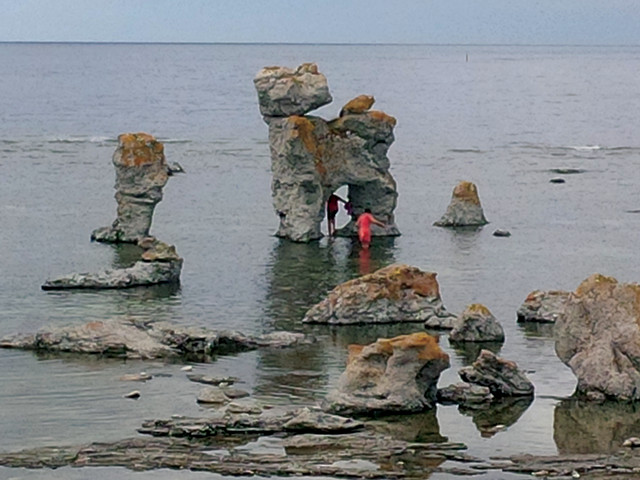
The largest of the sea stacks, called "the dog," looks like a terrier. Credit: Naomi Lubick
The next day, after a rich breakfast of thick oatmeal, dark breads, and breakfast meats and cheeses at the hostel, we hopped on our bikes, undeterred by a light rain, and retraced our steps to Fårö. This time, we absolutely needed to get to the dog. Pedaling down pebbled beach roads, we passed pine forest and the traces of a 1,000-year-old church. Nearby, an old fishing village and its harbor now sit tens of meters inland. A few hundred meters farther along, we finally stumbled upon the cluster of sea stacks where the dog stands.
The flat, shallow sea, and the position of the stacks about 20 metre, created an optical illusion that at first made the raukarna appear huge — until two people waded out to the dog and betrayed its true height, a little over 4 meters tall. The water depth never varied as the pair made their way out, reaching mid-thigh, and they had to crouch to fit beneath the arch between the dog’s “legs.”
Nevertheless, it was mesmerizing. We spent some time on the beach eating our picnic lunch, absorbing the metallic colors of the sea and the cream and mushroom colors of the rocks. It felt like we had made a pilgrimage. I would think about this later in the afternoon as we biked around Fårö in the rain and saw traces of Bergman and his films in various places, probably passing film buffs who were making a pilgrimage of a different sort to this island.
After another night at the hostel, we headed southwest in search of Gotland’s human dimensions, which date from long before the Middle Ages to the present. Near the little town of Slite, we stumbled across a huge quarry by the highway. Tunnels bored beneath the road allowed the convenient transport of calcium carbonate from the mine to the Cementa factory on the other side. Modern cement companies have worked on Gotland in different forms since the mid-1800s, but the production of lime mortar and the use of limestone and dolomite building stone have existed here for far longer.
A little farther down the road, we parked our car in the pines and walked down to one of Gotland’s white sand beaches to sit in the cold July sun and eat our lunch. Eventually, we mustered the courage to join the handful of Swedes wading hundreds of meters out on the flat reef bottom in the cold, cold Baltic waters. (I estimate it was about 18 degrees Celsius, or in the 60s Fahrenheit, but it felt much colder!)
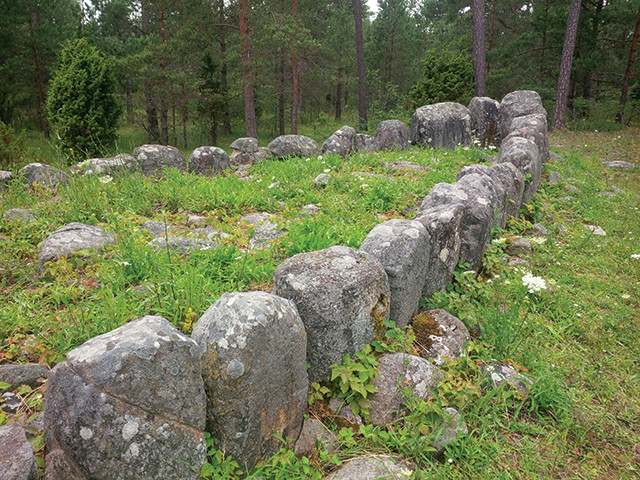
These "stone ships" are thought to be Bronze Age burial sites, but archaeologists have not found many actual remains. Credit: Naomi Lubick.
After drying off, we got back in the car and followed roadside signs to other historic sites. A long drive down a dirt road led us to the “stone ships,” rocks arranged in ellipses, with larger boulders at the tips, that look like funeral boats. The ships are thought to be Bronze Age burial sites, but archaeologists have failed to find many actual remains, leading them to hypothesize that cremation was the norm several thousand years ago. Nearby, a former human settlement is perched atop a hill, bounded by cliffs on one side. Later, we stopped at a Viking farm featuring wood barns with thatched roofs and a medicinal herb garden. A more modern Victorian house had been built across the yard from the large barn — all reminders of the island’s long history of human occupation.
On the last leg of the day, we drove through fields of sugar beets, and passed an old sugar-beet processing factory that is now a whiskey distillery. Our destination was Visby, the island’s largest city. That night and the next, we stayed a short drive south of Visby in a YMCA facility called Fridhems Pensionat. Far from an inexpensive dormitory for young men, however, the grand Swiss chalet was built by a Swedish princess in the 1800s, and lodging costs a bit more than the usual hostel.
We spent the last day of our tour wandering through the city’s 16 historic churches, many of which are open to the sky after centuries of neglect. The abundance of churches in Visby — now a town of about 24,000 inhabitants — speaks to the relative wealth and religious fervor of the 12th and 13th centuries. But poverty followed, and while some of the churches were scavenged for building materials, the people remained too poor even to raze them — so these skeletal stone structures remain, and are now protected as historical sites. The city’s encircling wall — another relic of Visby’s history from the Middle Ages on — includes a tower prison called the Kajsartornet, or Kaiser Tower, which was active from the 1680s to the 1800s. A look inside the museum that’s now housed there gives visitors a glimpse into everyday life and shifting moral codes of this time period, when those considered guilty of debt, infidelity or witchcraft were punished by imprisonment, torture, banishment or, sometimes, death.
Today, Visby is the site of an annual July gathering, called Almedalen Week after the elm trees in the city’s main park, where the country’s political elite come to discuss the important subjects of the day. Toward the end of summer, medieval re-enactors come to fight, barter and drink; we were there too early in the season for that pageant, but watching a woman repair woolen garments typical of the time gave us at least a glimpse of life there hundreds of years ago.
We ended our trip with a meal at Lilla Bjers, an organic farm with a restaurant in one of its greenhouses, serving a sophisticated menu of locally grown food: typically leafy greens and root vegetables, with the option to add organic lamb from the farm to the otherwise vegan menu. The restaurant’s shop included plants for purchase, as well as handwoven Gotland linen in traditional patterns. When we visited, Sweden’s crown princess and her husband had recently stopped in for lunch, and although it wasn’t cheap, the restaurant was unpretentious. The chef came out to speak to us about his sabbatical in California the previous November — the restaurant closes for a short off-season in fall, but opens again for a Julbord, or “Christmas table.”
We had walked from our YMCA lodgings that evening down a long straight lane, past a pasture, wrapped in layers of warm clothes to ward off the chill of a Swedish summer evening. The next morning, on our way to the ferry, we drove past that same pasture to take a closer look at a site that had puzzled us the evening before: a circle of standing stones, surrounded by grazing sheep.
The stones turned out to be an artist’s modern interpretation of Stonehenge. Had we arrived a few days earlier, we could have joined the locals for their summer solstice festivities — which offer a modern take on ancient celebrations of the longest day of the year — atop the vestiges of a tropical seascape.
© 2008-2021. All rights reserved. Any copying, redistribution or retransmission of any of the contents of this service without the expressed written permission of the American Geosciences Institute is expressly prohibited. Click here for all copyright requests.